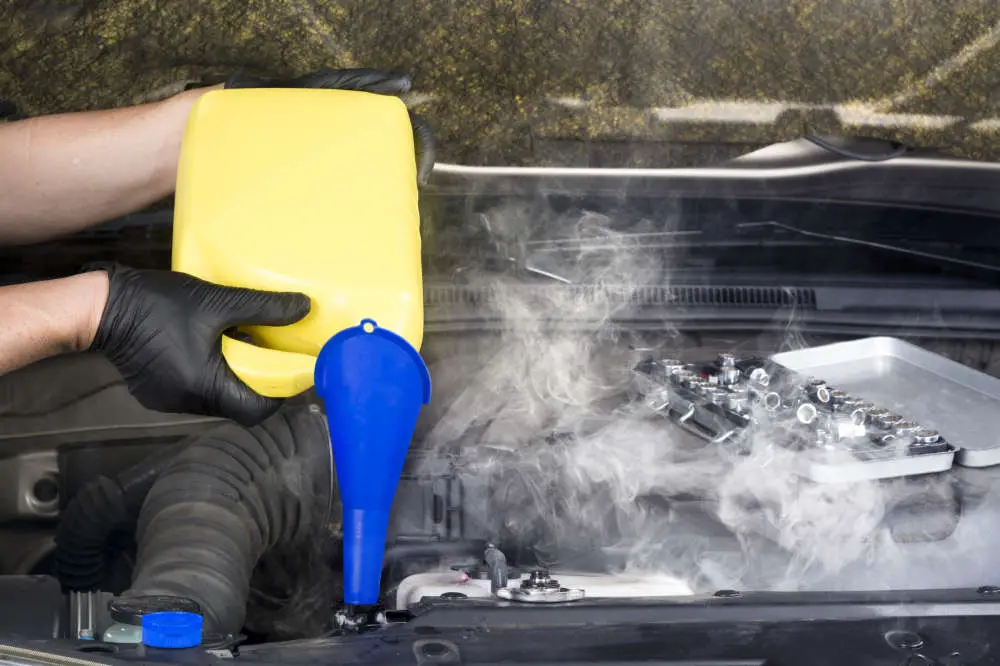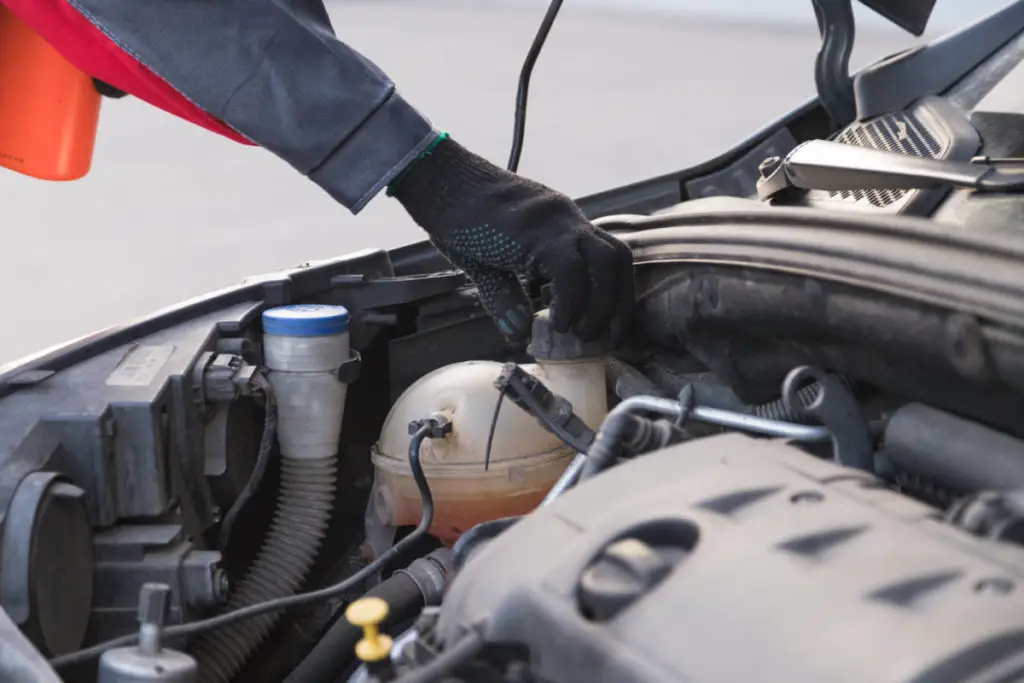Are you heading to work or school and suddenly get the coolant level warning? This can happen at any given time, but fret not!
Warnings are there to keep us aware of our car’s health. But they do not always mean that something is already too damaged to fix it.
In the case of the coolant warning, it’s a reminder to help you keep your Audi in good shape.
In this article, we will explain how to change your coolant liquid and what to look out for. As well as what coolant liquid to use and what to do if the warning doesn’t turn off.
Advertising links are marked with *. We receive a small commission on sales, nothing changes for you.
Why Does My Audi Say: Check Coolant Level?
When the engine coolant level is low, you will get a warning.
It will appear with a temperature light and the message: “Check Coolant! See owner’s manual”. Do not disregard the engine coolant warning light on an Audi or continue to drive with it.
But, what is a coolant? Coolant is a liquid or gas component that maintains your car’s engine temperature.
It is absolutely necessary for the right functioning of the engine. It prevents the liquids in your car to freeze or boil.
This is what you should do: Step-by-step-Guide

Here is a quick guide! With these steps, you’ll be able to remove the warning sign and continue with your driving.
The steps down below will be helpful to these Audi models:
- A3, S3, RS3, A4, S4, A5, S5, A6, S6, A7, S7, RS7, A8, S8, Q3, Q5, SQ5, Q7, TT, R8.
Before going through the guide, here is an IMPORTANT note you should look at before dealing with a warning sign.
Do NOT touch or open the coolant expansion cap or the radiator when the engine is hot. Instead, please wait for the engine to cool down. Then proceed.
Here are the detailed steps:
- Set the parking brakes and park your Audi on flat ground.
- Switch off engine and check the coolant level.
- Allow time for the engine to cool. You may now open the hood when the engine has cooled down.
- Pull the hood open using the lever until it pops open. Then, disengage the hood safety clasp at the front of the vehicle.
- Locate the engine coolant expansion reservoir, which is transparent.
- To identify the current level, look to the side.
- If the level is low, flip the cap counterclockwise to remove it. Be careful. If the engine is hot, do not remove the lid.
- Add engine coolant to bring the level between the MIN and MAX markings. Again, only use the Audi coolant recommended by Audi. It is 50 percent antifreeze and 50 percent distilled water, as described above.
What Coolant Does Audi Use?
Ensuring your Audi’s engine’s longevity and optimal performance hinges on choosing the right coolant.
G13 Audi Coolant / Antifreeze VW TL 774 J is the recommended coolant for most Audi models.
Other possible coolants mentioned in the search results include:
- PentoFrost E: This coolant is recommended for a complete flush and is compatible with VW, Audi, and Porsche.
- G11: This coolant was used in Audi model years 1997-2008.
- G12+: This coolant was used in Audi model years 2008-present.
- G12++: This coolant is compatible with all cooling systems from 1980-present.
Here’s a roadmap to guide you in making an informed decision:
- Consult Your Owner’s Manual: The first port of call should be your Audi’s owner’s manual. It provides specific recommendations on the type of coolant best suited for your vehicle. A quick online search should yield the desired information if your manual isn’t readily available.
- Prioritize OEM-Approved Coolants: Sticking to OEM-approved Audi VW G11, G12+, G12++, or G13 Audi coolant antifreeze is advisable. Off-the-shelf coolants from general stores might not align with the unique specifications of Audi’s cooling system. Using subpar coolants heightens the risk of inflicting damage to your engine.
- Factor in Your Vehicle’s Age and Origin: The optimal coolant for your Audi is influenced by its model, age, and manufacturing location. For instance, silicated HOAT coolants are the go-to for luxury brands like Mercedes-Benz, Audi, VW, Porsche, Bentley, and Lamborghini.
- Monitor the pH Value: The coolant’s pH value is pivotal in determining its compatibility with your Audi’s cooling system. Brands like Audi, Bentley, Skoda, VW, and Porsche typically require a pH value hovering around 8.5.
- Steer Clear of Mixing Coolants: Combining different coolant types can trigger adverse chemical reactions detrimental to your engine. It’s best to remain consistent with one coolant type and avoid blending various brands or formulations.
By adhering to these guidelines, you’re poised to make a choice that not only complements your Audi but also bolsters its engine’s performance.
How Do I Check the Coolant Level in my Audi?
Don’t worry; checking your coolant level is not that big of a deal.

Turn off the engine and check the coolant level in the radiator expansion tank.
It should be between the “MIN” and “MAX” markers while the engine is cold. When the engine is hot, it will be a little bit higher.
As said before, the warning light in the instrument cluster monitors the coolant level. But, you should check the coolant levels often!
If you notice your coolant liquid is missing more and more between each check-up, you might leak.
A loss of coolant usually indicates a leak in the cooling system. It can be other issues, but in general, it’s a leak.
A professional and skilled mechanic should examine the cooling system in this scenario. It’s not enough to top up the coolant.
Common Coolant Issues
- Discoloration: Over time, coolant can become discolored. This could indicate rust or other contaminants. Just as outdated content can harm a blog’s reputation, old coolant can damage an engine.
- Leaks: If you notice a drop in coolant levels without an apparent reason, there might be a leak. It’s essential to address this immediately.
- Overheating: If your engine overheats, it could be due to low coolant levels or a malfunctioning cooling system.
Frequently Asked Questions
Is it Safe to Drive With Coolant Light on?
The coolant warning light indicates that your engine is overheating due to a lack of coolant.
If this light has come on and you’re wondering if you can keep driving, the answer is no.
Overheating can cause engine damage, which can be very expensive to fix.
How Long Can You Drive After Coolant Warning?
You can drive for a while if your car’s coolant level is low. It all depends on the coolant level.
You can drive your automobile for a few days if it is low but above the minimum. But, if it is below the minimum, do not attempt to start your engine.
Can You Put Water in Audi Coolant Tank?
There would have been no need to construct anything like a coolant if water had sufficed. Coolant does not freeze at lower temperatures like water does. Water boils and evaporates in a heated range, while coolant does not.
This point alone explains why you can’t use water to replace the coolant.
What happens if all you put in there is water? Well, damage. A lot of it.
For example, during the winter, plugs would come out, and the water pump would block due to the freezing of the water.
It’s a different narrative with the same ending in the summer. Because of the boiling, air would enter the engine, affecting its performance. Besides, water will evaporate as the temperature rises, causing the engine to overheat.
Is Coolant the same as Antifreeze?
Technically, coolant is not exactly an antifreeze. But rather, it is made of it. Let us explain!
Coolant is what we call the mix of water together with antifreeze. Usually a 50/50 but there can be other percentages of the mix.
So, if you’d like to, you could call coolant antifreeze!

Luna Meschiari is a full-blooded car nut who is well known to local garages, as each article is meticulously researched and peppered with the latest piece of information. Guess what car she’s driving right now? A RAV4 2021 Hybrid. But her heart also sleeps for pickups like the F-150. Get to know Luna better on the about us page.
Advertising links are marked with *. We receive a small commission on sales, nothing changes for you.
